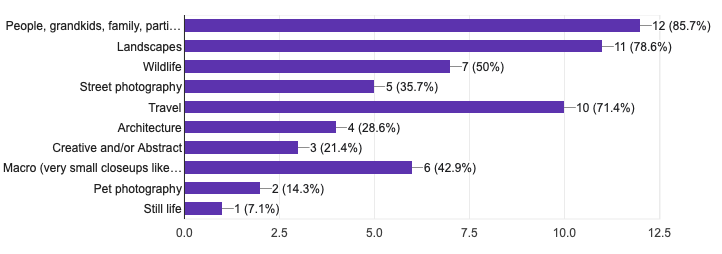The purpose of this challenge is to have some fun while we start to put more thought into the images we capture and attempt to apply different techniques or compositions to what you would usually do. I would suggest you take multiple images for each challenge, then pick your best couple (delete the rest), clean the finalists up with some basic editing and then pick your best one for sharing.
The plan is to gather together to discuss this before starting to review some basic techniques and ideas.
Scavenger Hunt (work in progress):
- Take a portrait of someone special, person or pet
- Abstract Art (think about lines, textures, colours)
- Landscape (remember rule of thirds and trying to get everything in focus)
- Something in motion
- Symmetry, maybe with a reflection or shadow
- A soft, calming image (think about greens, blues)
- A dramatic image
- Something with a shallow depth of field (like a flower) – subject should be sharply in focus, background blurred
- Architecture
- Take a picture of a common subject from a completely different angle
Tips for Challenge Items
Following are some tips for some of the scavenger hunt items.
- Portrait Photography:
- Make sure the eyes are in focus for close-ups or headshots
- Candids are fun, showing people involved in activity or discussions and not necessarily looking into the camera or posing
- Consider composition guidelines and use cropping to adjust later if needed
- Editing to soften face or remove blemishes is important for close-ups (note: portrait mode will often do some of this for you)
- Use indirect light, not direct sunlight on their faces especially for older subjects
- Shoot at subject’s eye level
- Shallow depth of field (sharp focus on subject, blurred background)
- Consider the background or location, how should this factor into your shot?
2. Abstract Image
- Consider a view of an object or scene around you taken in way that the end result may have interesting lines, colours or textures that does not immediately tell us what the actual object was
3. Landscape
- Typically we are shooting an outdoor scene with a foreground, mid ground, background, all in focus
- Important elements are composition, light, sharpness of all elements, although as with everything you can break all the rules if you have a creative concept
4. Motion ideas
- Fast shutter sports action
- slow shutter waterfalls or moving vehicles (requires a tripod)
- slow shutter star trails (requires a tripod and shutter open for many minutes)
- night shots with light trails (tripod typically)
- Panning shots
- timelapse sequences (technically this would be multiple images stitched together but smartphones can do this for you now)







